If you describe the concept of Sony a7C in the simplest possible terms, it will turn out something like this: this is a Sony a7 III with advanced autofocus and in the most compact body. Yes, indeed, we do not see anything significantly new here in terms of filling: the camera differs primarily in its concept. Sony a7C is more tailored for video bloggers and travel photographers. This is a kind of gift for those who were torn in their desires between full frame and compactness. Now there is no need to tear yourself apart: with the complete retractable lens 28-60 mm F4-5,6, the camera turned out to be really miniature. At the same time, there is professional power inside. Attractive? Perhaps.
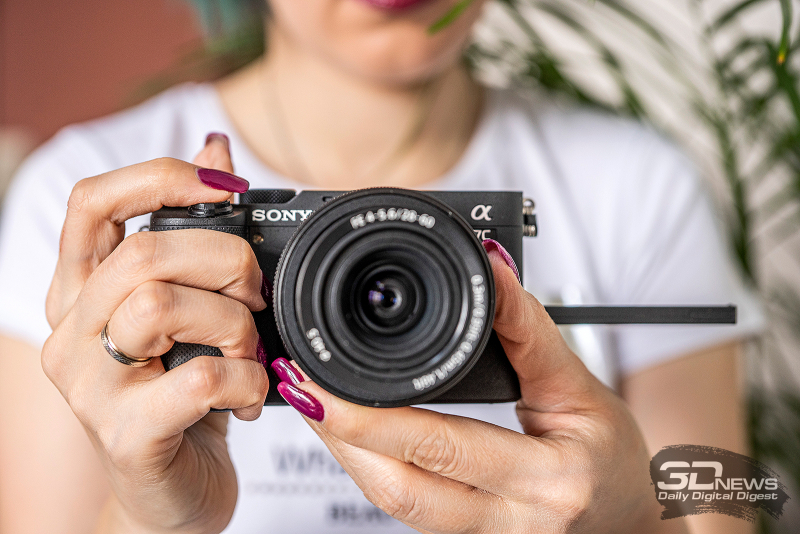
⇡ #Key Features. Differences from competitors
So, we have a camera with solid specifications: a full-frame 24-megapixel back-illuminated sensor (BSI-CMOS), a Bionz X processor – just like in the successful Sony a7 III. However, three whole years have passed since its release – a lot by the standards of the rapidly changing world of digital technology. Moreover, in terms of other characteristics, the novelty also repeats its more dimensional predecessor: the same video recording capabilities, the same burst shooting speed. Yes, the manufacturer has developed a new image stabilization system taking into account the compact size of the camera, but its essence has remained unchanged – this is a five-axis shake compensation system. The stabilization efficiency is also the same – 5 EV.
At the same time, the a7C weighs less than the a7 III, as much as 140 grams, and if you compare it with other closest competitors, the gain will be even more significant.
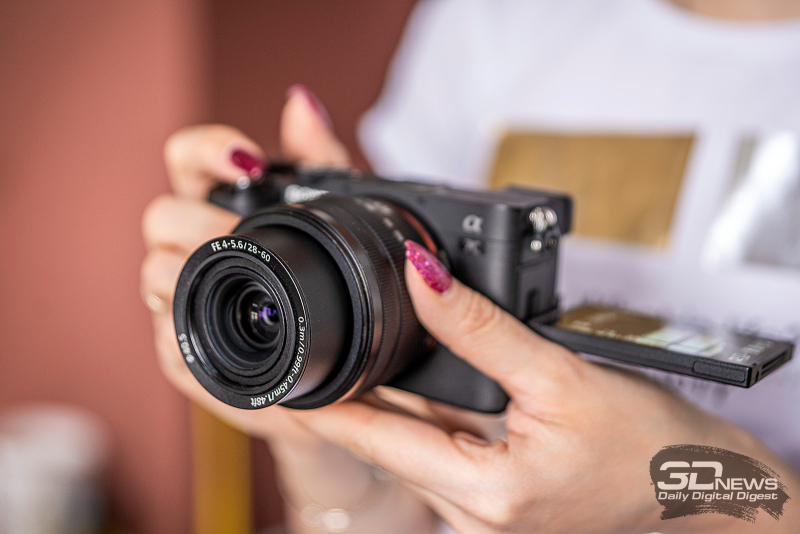
However, we understand that compactness requires certain sacrifices. Here we had to sacrifice, in particular, the viewfinder – it is smaller than that of the a7 III. Also, in the new camera, we see only one slot for memory cards – and we do not see the autofocus joystick. How serious this loss is – every photographer decides for himself. Over time, for example, I got used to the lack of a joystick, although during the first days my finger desperately tried to find it. In general, I do not use the viewfinder so often, and in those moments when I needed it, I felt a certain disappointment, but again bearable. But the lack of a second memory card slot for me is a more significant drawback, but only in those situations when it comes to responsible commercial filming. Obviously, not everyone buys a camera for this very purpose. Also, the Sony a7C uses a mechanical shutter with a maximum response speed of 1/4000 second – up to 1/8000 can only be “reached” with an electronic shutter. This is also a limitation – and still quite tolerable.

But there is good news: the manufacturer offers us the most advanced Sony autofocus system to date with real-time object tracking in both photo and video modes, as well as the ability to recognize the eyes of people and animals.
In addition, the battery life of the camera has been increased – and in this parameter the Sony a7C leaves far behind competitors from other manufacturers.
| Sony a7C | Sony a7 III | Canon EOS RP | Nikon z6 ii | Fujifilm X T4 | |
| Image sensor | 36 × 24mm (full frame) | 36 × 24mm (full frame) | 36 × 24mm (full frame) | 36 × 24mm (full frame) | 23,6 x 15,6mm (APS-C) X-Trans CMOS IV |
| Effective sensor resolution | 24 megapixels | 24 megapixels | 26 megapixel | 24,5 megapixels | 26 megapixel |
| Built-in Image Stabilizer | 5-axis | 5-axis | No | 5-axis | 5-axis |
| Bayonet mount | Sony E | Sony E | Canon rf | Z Nikon | Fujifilm X-mount |
| Photo format | JPEG (EXIF 2.3, DCF 2.0), RAW (ARW) | JPEG (EXIF 2.3, DCF 2.0), RAW (ARW) | JPEG (EXIF 2.3, DCF 2.0), RAW, Dual Pixel RAW, C-Raw | JPEG (EXIF 2.3, DCF 2.0), RAW (NEF) | JPEG (EXIF 2.3, DCF 2.0), RAW |
| Video Format | XAVC S, MP4 | XAVC S, AVCHD 2.0, MP4 | MOV, MP4 | MP4 | MPEG 4 |
| Frame size | Up to 6000 × 4000 pixels | Up to 6000 × 4000 pixels | Up to 6240 × 4160 pixels | Up to 6048 × 4024 pixels | Up to 6240 × 4160 pixels |
| Video resolution | Up to 3840 × 2160, 30p | Up to 3840 × 2160, 30p | Up to 3840 × 2160, 25p | Up to 3840 × 2160, 30p | Up to 4096 × 2160, 60p |
| Sensitivity | ISO 100-51200 expandable to 50, 102400 and 204800 | ISO 100-51200 expandable to 50, 102400 and 204800 | ISO 100-40000 expandable to ISO 50, 51200 and 102400 | ISO 100-51 200 expandable to 50-204 800 | ISO 160-12800 expandable to ISO 80-51200 |
| Shutter | Mechanical shutter: 1 / 4000-30 s; long (Bulb); silent mode |
Mechanical shutter: 1 / 8000-30 s; long (Bulb); silent mode |
Mechanical shutter: 1 / 4000-30 s; long (Bulb) |
Mechanical shutter: 1/8000 – 30 s; long (Bulb); silent mode |
Mechanical shutter: 1 / 8000-30 s; electronic shutter: 1 / 32000-1 s; long (Bulb); silent mode |
| Burst Speed | Up to 10 fps with mechanical shutter | Up to 10 fps with mechanical shutter | Up to 5 fps in normal mode, up to 4 fps with focus tracking | Up to 14 fps with mechanical shutter | Up to 15 fps with mechanical shutter, up to 30 fps with electronic shutter |
| Auto focus | Hybrid (contrast + phase), 693 points | Hybrid (contrast + phase), 693 points | Dual Pixel CMOS AF with coverage up to 88% of the sensor horizontally and up to 100% vertically | Hybrid (contrast + phase), 273 points | Hybrid (contrast + phase), 425 points |
| Exposure metering, operating modes | Matrix metering, 1200 zones: matrix, center-weighted, spot, spot on standard / large area, averaged over the entire screen, over the brightest area | Matrix metering, 1200 zones: matrix, center-weighted, spot, spot on standard / large area, averaged over the entire screen, over the brightest area | TTL 384-zone metering: evaluative, partial, center-weighted, spot | TTL sensor: matrix, center-weighted, spot, highlight | TTL metering at 256 points: multipoint, center-weighted, average-weighted, spot |
| Exposure compensation | ± 5,0 EV in steps of 1/3 or 1/2 EV | ± 5,0 EV in steps of 1/3 or 1/2 EV | ± 5,0 EV in 1/3 or 1/2 stop increments | ± 5,0 EV in steps of 1, 1/3, or 1/2 EV | ± 5,0 EV in steps of 1/3 EV |
| Built-in flash | No, X-sync 1 / 160 with |
No, X-sync 1 / 250 with |
No, X-sync 1/180 sec. | No, X-sync 1 / 200 with |
No |
| Self-timer | 2 s, 5 s, 10 s; self-timer for shooting with bracketing; self-timer for continuous shooting (up to 3 frames) | 2 s, 5 s, 10 s; self-timer for shooting with bracketing; self-timer for continuous shooting (up to 3 frames) | 2 / 10 with | 2 s, 5 s, 10 s, 20 s; from 1 to 9 exposures with an interval of 0,5; one; 1 or 2 s | 2 / 10 with |
| Memory card | Slot for SD / SDHC / SDXC type UHS II | Two slots, one compatible with Memory Stick (PRO, Pro Duo) and SD / SDHC / SDXC type UHS I / II, the other for SD only | Slot for SD / SDHC / SDXC type UHS II | Two slots: one for XQD / CFExpress, one for SD / SDHC / SDXC type UHS II | Two SD / SDHC / SDXC slots (UHS-II) |
| Display | Touchscreen rotary, LCD, 3 inches, resolution 0,92 million points | Touchscreen tilting, LCD, 3 inches, resolution 0,92 million points | Touchscreen rotary LCD, 3 inches, 1,04 million dots | Touch tilting LCD, 3,2 inches, resolution 2,1 million dots | 3 inches, 1,62 million dots, swivel |
| Viewfinder | Electronic (OLED, 2,36 million dots) | Electronic (OLED, 2,36 million dots) | Electronic (OLED, 2,36 million dots) | Electronic (OLED, 3,69 million dots) | Electronic (OLED, 3,69 million dots) |
| Interfaces | USB Type-C (USB 3.2), 3,5mm headphone jack, 3,5mm microphone jack, microHDMI type D | USB Type-C (USB 3.0), microUSB, 3,5mm headphone jack, 3,5mm microphone jack, microHDMI type D | HDMI, USB 2.0 (USB Type-C), 3,5mm for external microphone, 3,5mm for headphones, remote control port | microHDMI, USB 3.2 (USB Type-C), 3,5mm for external microphone, 3,5mm for headphones, remote control port | microHDMI, USB 3.2 (Type-C), 3,5 mm for external microphone, 2,5 mm jack for remote control |
| Wireless modules | Wi-Fi, NFC, Bluetooth | Wi-Fi, NFC, Bluetooth | Wi-Fi, Bluetooth | Wi-Fi, Bluetooth | Wi-Fi, Bluetooth |
| Food | Li-ion battery NP-FZ100, 16,4 Wh (2280 mAh, 7,2 V) | Li-ion battery NP-FZ100, 16,4 Wh (2280 mAh, 7,2 V) | Li-ion battery LP-E17 with a capacity of 7,5 Wh (1040 mAh, 7,2 V) | Li-ion battery EN-EL15b, 16,42 Wh (2280 mAh, 7 V) | Li-ion battery NP-W126S with a capacity of 15,84 Wh (2200 mAh, 7,2 V) |
| Dimensions | 124 × 71 × 60 mm | 126,9 × 95,6 × 73,7 mm | 133 × 85 × 70 mm | 134 x 101 x 70 mm | 135 × 93 × 84 mm |
| Weight | 509 grams (with battery and memory card) | 650 grams (with battery and memory card) | 485 grams (including battery and memory card) | 705 grams (with battery and memory card) | 607 grams (with battery and memory card) |
| Actual price | 125 900 rubles for the version without a lens (body), 173 900 rubles for the version with a lens (kit) | 149 rubles for the version without lens (body) | 74 rubles for the version without a lens (body), 500 rubles for the version with a lens (kit) | 169 rubles for the version without a lens (body) with an FTZ adapter, 990 rubles for a version with a lens (kit) and an FTZ adapter | 139 rubles for the version without a lens (body), 900 rubles for the version with an 167-900mm f / 18-55 lens (kit) |
Design and ergonomics
Visually, the Sony a7C resembles the Sony a6600 more than the manufacturer’s full-frame cameras, but it is unique – it has its own body, and not from any other model. The camera is available in two colors – completely black and black and silver. Camera dimensions – 124,0 × 71,1 × 59,7 mm, weight with battery and memory card – 509 grams. The manufacturer proudly calls it the lightest and most compact camera in the world, while stipulating that we are talking only about full-frame “mirrorless” with a built-in stabilization system and only when used with a complete lens. Stabilization aside, the Canon EOS RP will already compete for the title of the lightest, but the Sony a7C is really more compact. It impresses with its miniature dimensions for its class – and at the same time manages to look quite solid and reliable. The body is made of magnesium alloy – the manufacturer tried to make the structure as solid and sealed as possible in order to provide protection from dust and moisture. This is a very important moment for those photographers who are planning to use the Sony a7C as a travel camera.
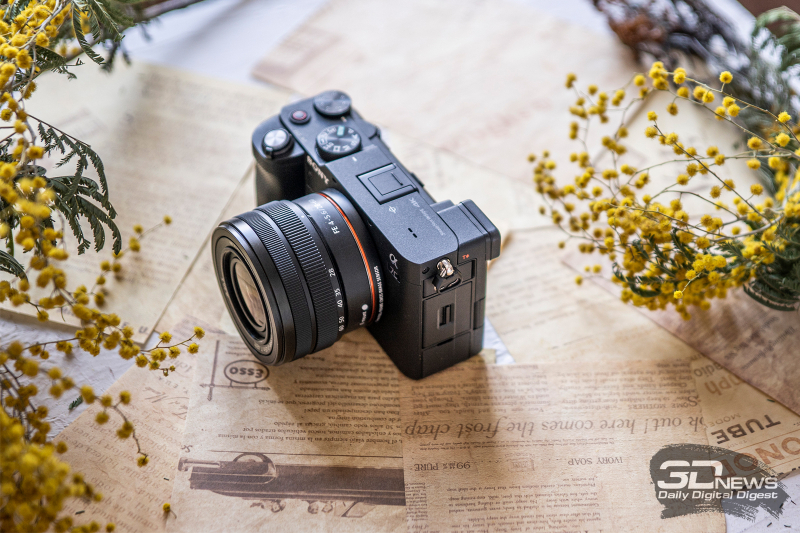
The task before the creators was not an easy one – to minimize the size and at the same time preserve the ergonomics to the maximum. In my opinion, the balance has been found as a whole. No, the a7C is not the most convenient camera in the world: the same lack of a joystick, which I already wrote about, is very unusual. You have to get used to the management. For example, I didn’t like the camera on / off switch – it was very tight and tactilely unpleasant. However, there are also many successful moves. For example, I am glad that the camera has an exposure compensation wheel, which, in theory, could be dispensed with, and that the controls are not “shallow”. Separately, I would like to note the design of the screen, but we will move on to it later. In the meantime, take a closer look at the Sony a7C from all sides.
On the left edge, under three different plastic covers (which is nice separately: rubberized covers seem less convenient to me), there is a row of ports for connecting the camera to external devices. Above is a 3,5 mm microphone jack. In the center is a memory card slot (the camera supports all types of SD cards, including SDHC / SDXC and UHS-I / II). Under the bottom cover are USB Type-C and microHDMI ports and a 3,5 mm headphone jack.
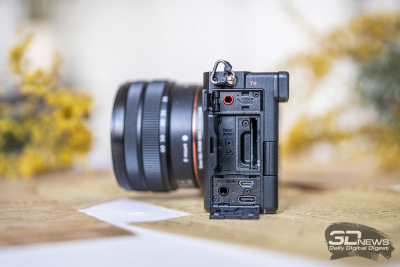 |
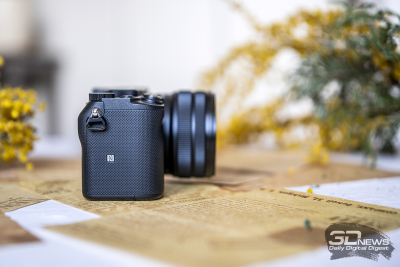 |
There are no controls on the right edge of the camera, while there is a contact pad for the NFC module.

On the top panel there are a “hot shoe”, a dial for shooting modes, a shutter button with a camera on / off lever, a video recording button and an exposure compensation input wheel.
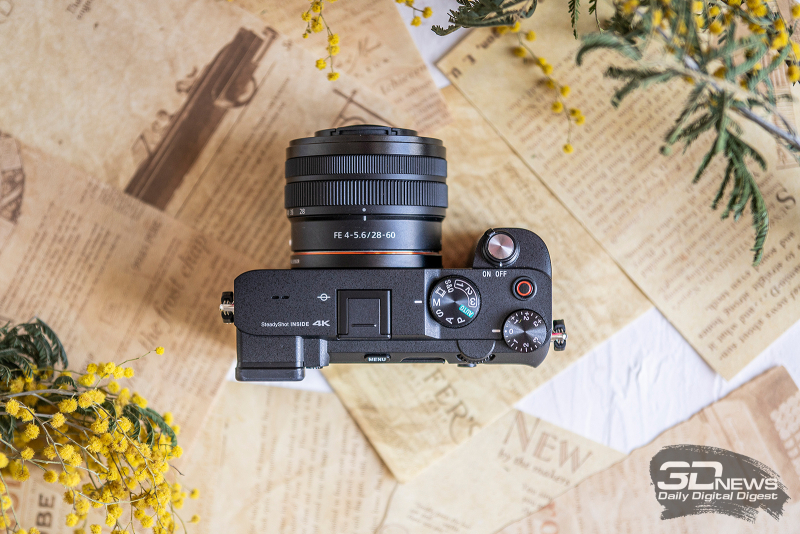
A tripod socket and a battery compartment are located at the bottom. They are located at a considerable distance from each other, which makes it possible to change the battery without removing the camera from the tripod.
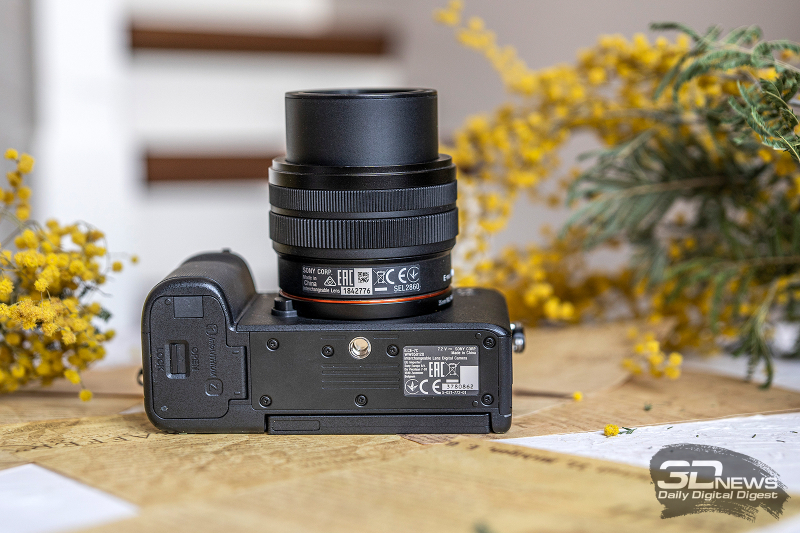
Most of the front surface of the camera is occupied by the E-mount. Nearby is the lens release button, as well as the autofocus lamp. The Sony a7C has a small, but comfortable enough grip, covered with leather-like material, so that the camera grips securely in the hand.
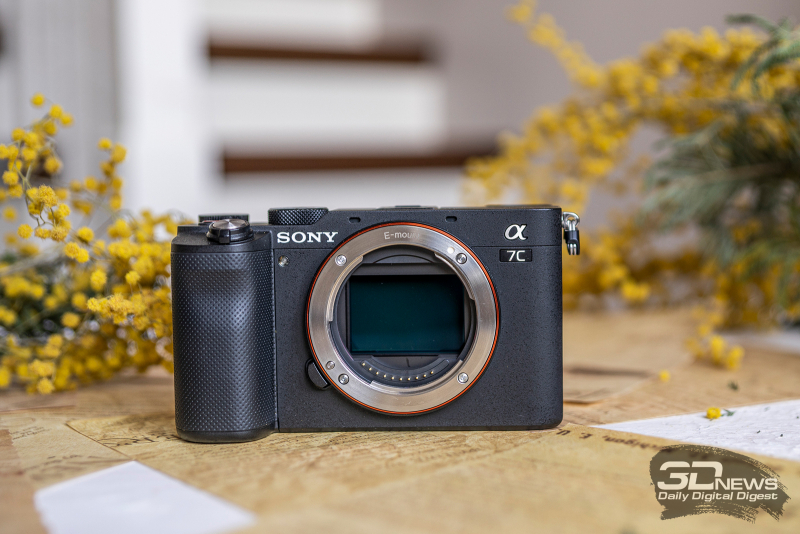
At the back are the viewfinder, forced autofocus and menu buttons, a control wheel, Af-On and quick menu buttons, a selector dial with function keys and buttons for playing and deleting files.
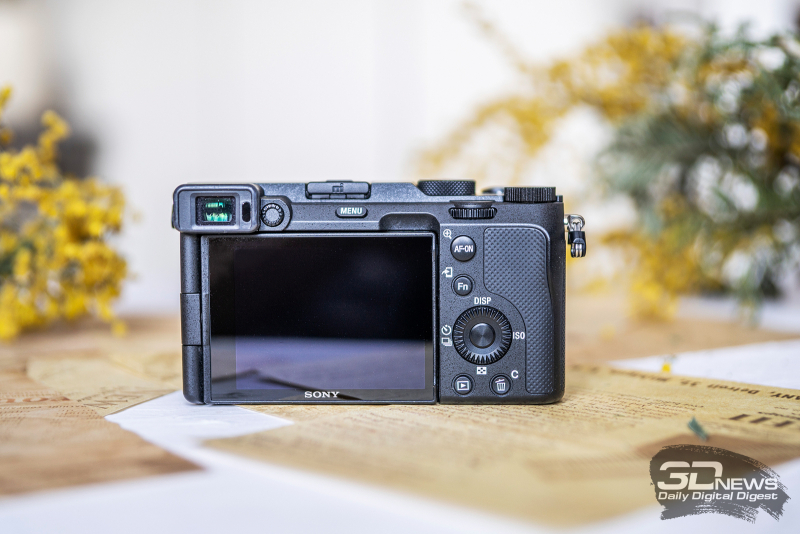
As you can see, there are not very many controls, which allowed us to make them of a normal size. It is quite difficult to miss when driving, everything is located logically and rather sparsely.
Display and viewfinder
The Sony a7C is equipped with a 7,5 cm LCD display with a resolution of 921 dots. Compared to the a600 III, it is fully swivel design that allows you to shoot from any awkward angles, take selfies or blog. And also, which is very convenient, to cover the screen when not in use: this protects it from scratches and dirt. Of course, the display is touch-sensitive, with its help you can focus and release the shutter. Everything sounds good, but, frankly, I was puzzled by the image quality: despite the fact that I did not set the brightness to maximum, every now and then there was a feeling that the picture was overexposed, although in reality everything was in order with the exposure.
 |
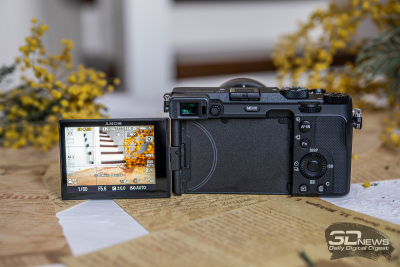 |
The viewfinder is located in the upper left corner of the body. It has the same resolution as the a7 III at 2,36 million dots, but using a smaller panel only yields a magnification of 0,59x, significantly less than most mirrorless cameras. The viewfinder feels unusually small, and of course this makes it less comfortable to work with. Perhaps the manufacturer proceeded from the assumption that most of the potential audience of the a7C will sight images across the screen and compactness is more important to them than a good viewfinder.
It was a disappointment for me that neither the screen nor the viewfinder provide the proper image level, although when viewed on a computer, the pictures look right. Still, I want to enjoy the picture already in the process of shooting.
⇡ #Interface
The a7C’s menu design is familiar to anyone with experience with a6000 or a7 series cameras. The innovations that appeared in the a7S III did not reach the heroine of our review. The camera menus are organized horizontally and each section contains a large number of pages. In general, it feels quite cumbersome, and an untrained user can get confused. It will take a while to remember where the required parameter is.
Of course, the camera also has a quick menu called up with the “Fn” button, where the user can add 12 of the most popular settings. Like other recent Sony models, the a7C also allows you to create separate Quick Menus for stills and movies, reducing the need to access the main menu frequently.
Wireless connections
Sony a7C is equipped with a Wi-Fi module with support for the 5GHz band, which allows you to provide faster connection to other devices. There is also Bluetooth 4.1, which is used exclusively to receive GPS data from the phone.
For the transfer of footage and remote control, as always, is the responsibility of the proprietary Imaging Edge Mobile application, familiar to users of other Sony cameras. The application is convenient and functional – for example, it allows you to use the a7C as a webcam for online broadcasts and video conferencing.
⇡ #Camera in operation
The camera came to my test with the only complete lens Sony FE 28-60 mm f / 4-5,6. Its undoubted charm is in its special compactness and the most popular focal lengths, but, of course, it does not fully reveal the potential of the device. High-aperture optics will help open new facets of the a7C, but this is already a question of the user’s priorities. For example, a travel blogger may not really need shots with a shallow depth of field and expressive bokeh, because he specializes in landscape photography. And this is where compactness comes to the fore.
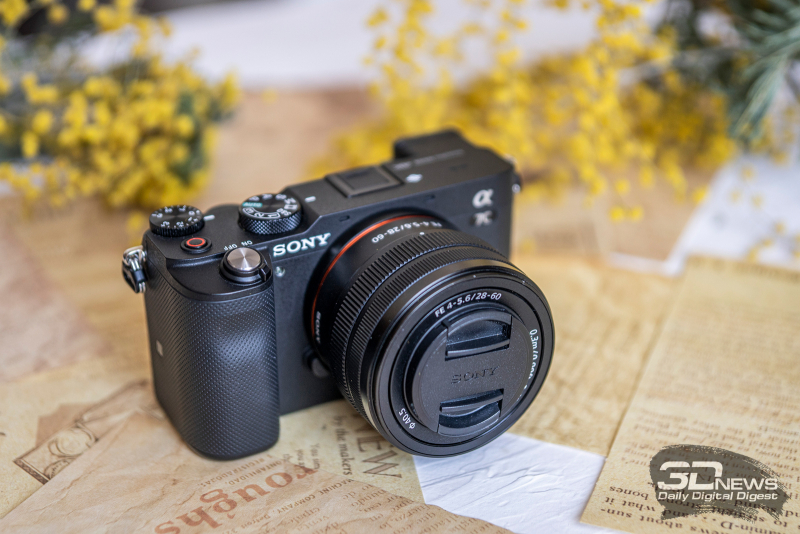
The camera test took place in March – the month in the Central Russian lane is gray and dull. I tried as best I could to make as many different shots as possible, but somehow all these factors blur the overall pleasure of the shooting process a little. Of course, in hot countries and with top-end optics, the impressions of the camera would be somewhat different – both for me, as the person who writes the review, and for the viewer. But we will try to objectively assess the technical aspects of the frames, making allowances for not the most epochal content.
Obviously, due to the same “stuffing”, the quality of the pictures will be on the whole the same as that of the Sony a7 III, but nevertheless we will consider them in more detail. The most significant difference between the a7C and the a7 III is that the a7C only offers first-curtain electronic shutter or fully electronic shutter modes. There is no completely mechanical shutter here. Recall that the electronic drive of the front curtain can cause background blur distortion, especially noticeable in defocused light areas at short shutter speeds. In fact, the effect is small – you can notice some artifacts only at the minimum aperture (from f / 1,8 and below) with extremely short shutter speeds (from 1/4000).
Shooting in JPEG
JPEG shots look very decent and balanced. The camera is distinguished by quite correct color rendition – including skin tone.
|
|
|
Taking into account the sensor resolution, which is not the highest by today’s standards (remember, 24 megapixels), the detail in the pictures is very decent and sufficient for most photographic tasks.
|
|
 |
|
|
Left – original image, right – crop. F / 7,1, 1/100 sec, ISO 100 |
||
The manufacturer offers a number of possibilities for modifying the picture directly at the time of shooting. First, the user can select one of the art modes: Standard, Vivid, Neutral, Clear, Deep, Light, Portrait, Landscape, Sunset, Night Scene, Fall Foliage, B / W, Sepia, Stylish Frame. Most of them make small adjustments to the contrast, saturation and color of the frame.
|
|
.400.jpg) |
|
|
Left – Standard Art Mode, Right – Landscape |
||
You can more radically interfere with the look of the picture by applying one of the proprietary “picture effects”: toy camera, explosive color, posterization, retro, soft bright background, partial color filters (R / G / B / Y), high-contrast monochrome, rich monochrome. If you use them in moderation and to the place, it will turn out to be a good idea to diversify your shots. This is relevant for those users who do not like to sit for processing, but want something special. Unfortunately, activating the “picture effect” option is only available in JPEG format, which is inconvenient for me personally: if, when viewing on a computer, it becomes clear that the in-camera mechanisms did not give the desired result, it is always nice to have a “spare” RAW that can be processed on your own. taste.
|
|
|
|
|
Examples of shooting with the “picture effect” |
||
⇡ #Shooting in RAW, dynamic range
It is difficult to judge with certainty whether Sony’s new product is primarily aimed at photographers shooting in JPEG or RAW, but it is obvious that RAW format remains the preferred format for demanding shooting or shooting with difficult lighting – and it is he who fully reveals the potential of the camera.
As usual on Sony cameras, the user can shoot either uncompressed RAW (which I did when shooting for the review) or lossy compressed, while competitors from other manufacturers often have a RAW format with lossless compression.
I edited the photos for the review in Adobe Camera Raw. I have chosen several contrasting scenes as examples. The purpose of processing is to bring the photo into balance, it is better to reveal the highlights and brighten the shadows.
|
|
.400.jpg) |
|
|
.400.jpg) |
|
|
.400.jpg) |
|
|
.400.jpg) |
|
|
.400.jpg) |
|
|
Left – in-camera JPEG, right – RAW converted with settings to your liking |
||
The a7C has a decent dynamic range. Both lights and shadows “stretch” quite well.
Download images in RAW format (183 MB)
⇡ #Autofocus, burst and buffer
Autofocus is one of the strengths of the Sony a7C. Compared to what we saw in the Sony a7 III, the algorithm has been further refined, resulting in faster, more accurate focusing – the most advanced autofocus system Sony has to date. It is hybrid, with 693 phase focus points and 425 contrast focus points. The Sony a7C is capable of tracking any subject in both stills and movies, and automatically uses eye, face or head recognition where needed. Moreover, the camera is able to recognize not only people, but also animals – dogs, cats and birds. For example, in the photo below, the camera was correctly pointing the cat’s eye, despite the fact that it takes up a very small area of the frame.
The traditional test is shooting a person running towards the camera. And here the a7C worked flawlessly! The result is really impressive, in all the photos the focus is in place. This is one of the best metrics we’ve seen in similar tests.
|
|
|
|
In general, autofocus performed well, including when shooting in low light conditions and in complex / mixed light. Except that sometimes I missed the joystick in situations where the focus was on one point – I had to resort to touch control, which somewhat lengthened the process.
⇡ #Stabilizer
The Sony a7C features a 5-axis image stabilization mechanism that compensates for five types of camera shake. Stabilization efficiency according to CIPA standard – 5 steps. In practice, I tested it by hand-holding night landscapes. The next shot was taken at a shutter speed of 1/13 and a focal length of 60 mm. The sharpness is pretty good.
This frame was taken at a shutter speed of 1/10 and a focal length of 47 mm:
I was able to take photos worthy of sharpness at longer exposures, but here only some frames from the series turned out to be of high quality. My best result is this shot at 1/4 shutter speed and 60mm focal length:
It should be understood that the results may vary depending on the shooting conditions and the strength of the photographer’s hands, but on the whole the a7C has justified the hopes placed on it: the stabilizer works conscientiously and helps out well in situations where there is no way to use a tripod and do not want to overestimate the photosensitivity too much.
⇡ #Shooting on high ISO
The sensitivity range of the Sony a7C is ISO 100-51, expandable down to ISO 200 and up to ISO 50.
The Auto ISO system allows you to specify the lower and upper limits for ISO, as well as the minimum shutter speed to be maintained. This threshold can be defined either as a fixed shutter speed, or as a value relative to the current focal length: it can be equal to 1 / [Focal length], be proportionally longer or shorter. Auto ISO is available in manual exposure mode, in both photo and video modes.
It is logical to expect that the noise level of the new product will be the same as that of the Sony a7 III, because the main filling has not changed, and only minor factors such as heating the camera can affect the result.
Let’s take a look at some practical examples shot at high ISO settings and then move on to a test scene. All JPEGs are made with standard noise reduction.
ISO 2000 – smooth picture in both RAW and JPEG.
|
|
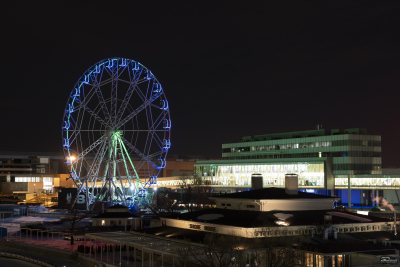 |
|
|
Left – intra-camera JPEG, right – RAW converted with default settings |
||
The next photo was taken at ISO 5000. It also looks absolutely decent. In RAW, noise is noticeable when you zoom in, but it is still quite delicate. In JPEG, the noise reduction has practically erased them – the picture is a little blurry from this, but again this is visible only if you zoom in on the picture. Everything looks good when viewed on a large monitor.
|
|
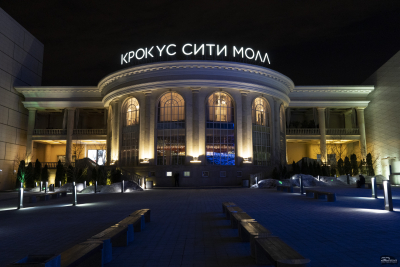 |
|
|
Left – intra-camera JPEG, right – RAW converted with default settings |
||
At ISO 6400, the overall picture is about the same.
|
|
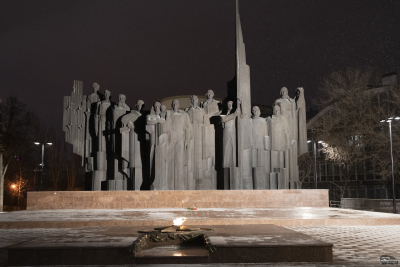 |
|
|
Left – intra-camera JPEG, right – RAW converted with default settings |
||
But this scene was shot at ISO 8000: here the noise is clearly distinguishable in the sky in RAW, while in JPEG the sky is rather simply irregular.
|
|
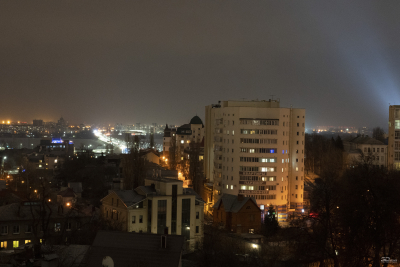 |
|
|
Left – intra-camera JPEG, right – RAW converted with default settings |
||
At the same time, the scene, shot with a darker sky at ISO 12800, also looks quite high quality.
|
|
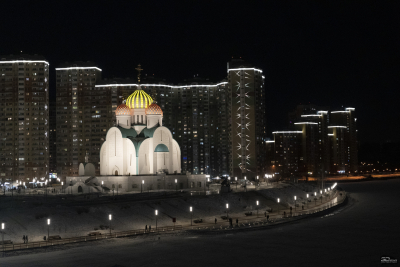 |
|
|
Left – intra-camera JPEG, right – RAW converted with default settings |
||
Download images in RAW format (165 MB)
And now for the test frames:
|
|
 |
|
|
|
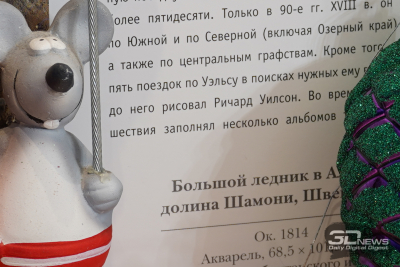 |
|
|
|
 |
|
|
|
 |
|
|
|
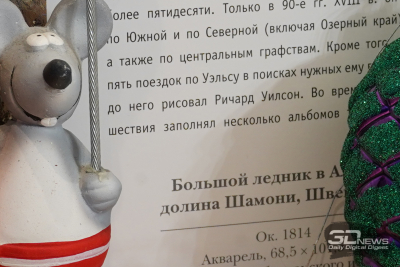 |
|
|
|
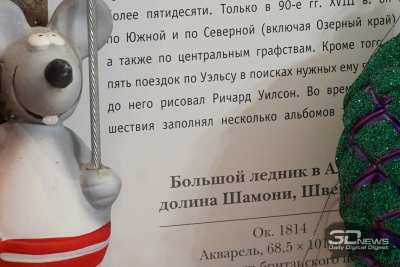 |
|
|
|
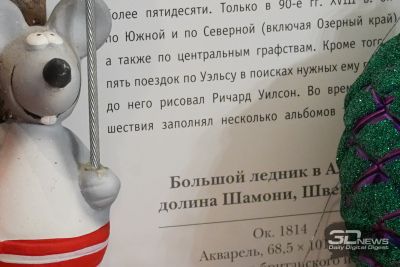 |
|
|
|
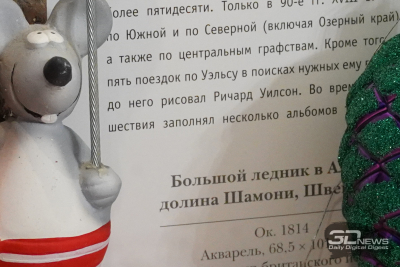 |
|
|
|
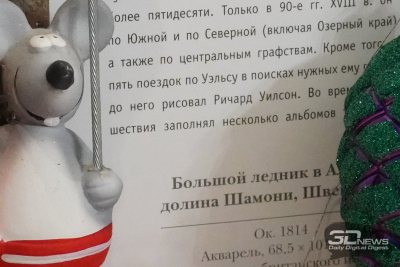 |
|
|
|
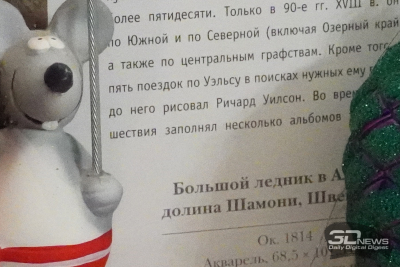 |
|
|
|
 |
|
|
|
 |
|
Download images in RAW format (457 MB)
Well, the Sony a7C is doing really well. Not only the upper value (ISO 51), but also the extended (ISO 200) can be called acceptable for shooting – with an allowance, of course, for the drop in detail and deterioration in color rendition. ISO 102 400 is good enough to formally capture something in the photo, but due to the abundant color noise and general “blur” of the picture, it is hardly suitable for artistic shots.
⇡ #Videography
The Sony a7C looks like a very attractive camera for vloggers. Its modest size allows you to easily carry it on an outstretched hand or a selfie stick, a swivel screen – to record yourself, excellent autofocus – to always be in the field of focus, a stabilizer – to create a smooth and pleasant looking picture even on the move. Add to this the absence of restrictions on the length of the recording, the absence of overheating, the ability to connect external accessories – and we get one of the most attractive devices of its kind.
The camera also supports vertical video format, popular, for example, when shooting Stories or “tik-tok”: metadata allows you to play and edit video footage shot in this way in a vertical position, without turning it over.
Download video in original quality (192 MB)
As an accessory, the manufacturer offers, firstly, an additional GP-VPT2BT grip with Bluetooth, with which you can control recording, zoom, and also use it as a tripod for hands-free shooting. Secondly, an ECM-B1M variable directivity microphone or an XLR-K3M adapter, which are connected via the multi-interface connector. The audio will be transmitted as a digital signal. This makes it possible to record high-quality sound without unnecessary audio cables.
Download video in original quality (248 MB)
The maximum resolution for shooting video on the Sony a7C is 3840 × 2160 at up to 30 frames per second. The camera supports slow motion (5x) and fast (maximum 60x) shooting when recording in Full HD at 120 frames per second.
Download video in original quality (324 MB)
Download video in original quality (208 MB)
In Movie Mode, the same Picture Effect, Creative Style and Picture Profile are available as in Still Image Mode.
From the innovations – from the Sony a7S III, the function of fixing the auto white balance has migrated here.
⇡ #Autonomy
The battery life of the Sony a7C is really impressive. According to the manufacturer, a single charge is enough to take up to 680 shots using the viewfinder or up to 740 shots using the LCD monitor. When shooting video, you can shoot continuously for up to 220 and up to 215 minutes, respectively. During the test, I did not manage to reach a complete discharge of the camera (I recharged it to start a new day with a full battery), but the fact that it discharges noticeably slower than its direct competitors is a fact.
 |
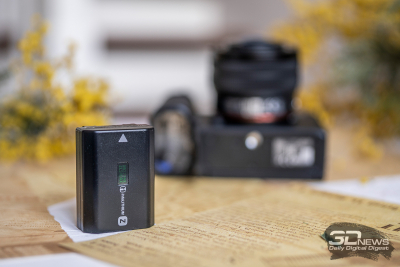 |
A definite plus – the camera can be charged via the USB port, while continuing to shoot. It is very important, again, for bloggers or journalists who plan to record interviews or some other lengthy video content on a7C.
⇡ #Conclusion
Sony a7C – on the one hand, it is a camera that seems to have nothing to surprise us with. She took all the stuffing from her already middle-aged predecessor Sony a7 III. The quality of the photo is, accordingly, identical. Why is it needed in 2021?
And here you need to understand that although these two cameras are very similar, they are still designed for different audiences. Sony a7 III is primarily a camera for professional photographers and enthusiastic amateur photographers. Sony a7C is a device more tailored for video shooting. It does offer a very appetizing feature set for a blogger, and most importantly, a truly excellent autofocus, improved over what was used in the a7 III.
All in all, being able to get the full power of a professional camera in such a small and lightweight body looks appealing. The Sony a7C is sure to appeal to travel photographers who don’t want to choose between full frame and convenience. The swivel display, long battery life and generally not-so-noticeable appearance will also be appreciated by street photographers who want to stay mobile and not draw too much attention to themselves. Of course, they will also love the fast and accurate AF with the ability to track any subject.
This camera may well be suitable for family shooting, as it allows you to take very high-quality portraits (in particular, children and animals in motion – thanks to the excellent mechanism for recognizing and tracking faces and eyes), without going into all the subtleties of settings.
Also, the Sony a7C is an excellent option for a second camera, for example, for wedding photographers: it does not take up much space in a backpack, but at the same time, with good optics, it will give results no worse than more “serious” devices. The complete lens, by the way, is also quite good, despite not the most impressive aperture – it is he who largely ensures the camera’s compactness.
Yes, the viewfinder was sacrificed for compactness – it is frankly uncomfortable to work with it. Yes, a strange screen is installed, and yes, the ergonomics are not as comfortable as in the same Sony a7 III. But, in my opinion, this can be reconciled.
Download RAW files (1,42 GB)
Advantages:
- compactness in combination with a full-frame sensor;
- dust and moisture protection, build quality;
- pivoting (not tilting) screen;
- good complete lens;
- excellent autofocus with a system for recognizing not only people, but also animals;
- Best-in-class battery life
- the ability to charge from USB while the camera is running;
- excellent video shooting capabilities;
- effective 5-axis stabilization;
- high-quality pictures in JPEG;
- good dynamic range in RAW;
- good shooting capabilities at high ISO.
Disadvantages:
- not the most comfortable ergonomics;
- the viewfinder is very small and uncomfortable to use;
- unsuccessful screen matrix;
- inability to access the menu when writing to the card;
- most of the settings are saved for photos and videos, so when switching it is necessary to change a few settings;
- the absence of a fully mechanical shutter, the risk of motion distortion when shooting with a wide aperture and the fastest exposure possible.
If you notice an error, select it with the mouse and press CTRL + ENTER.





